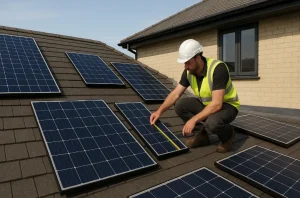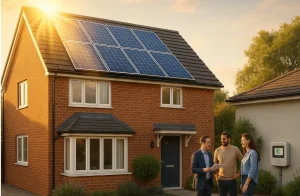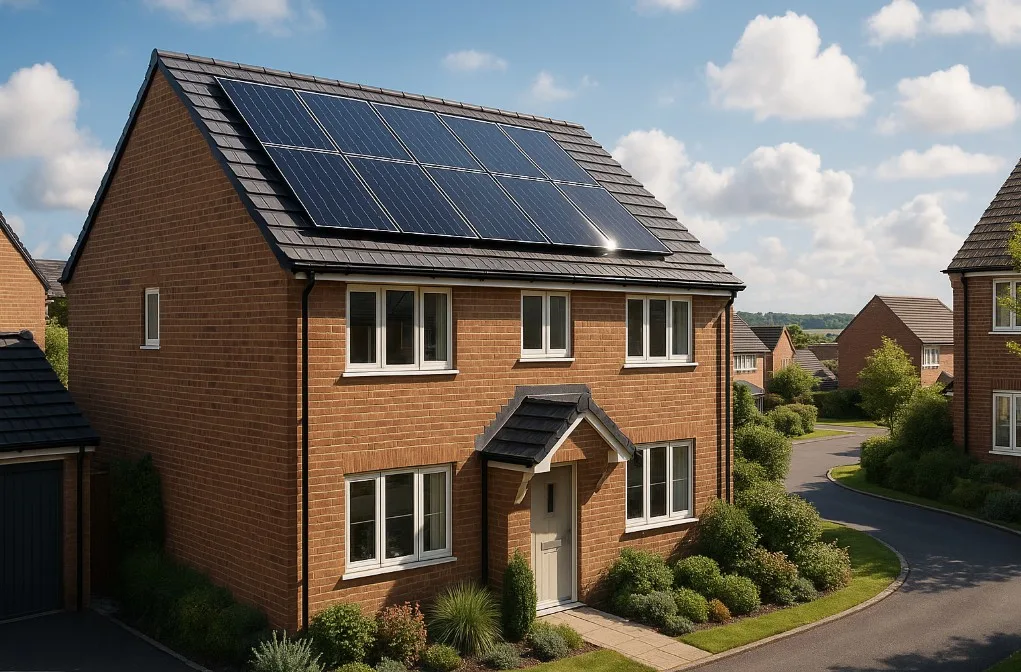Table of Contents
ToggleHow much does it really cost to install solar panels in the UK today? With rising energy prices and growing environmental awareness, more homeowners are asking this question than ever before. Installing solar panels can reduce long-term electricity bills and carbon emissions, but the upfront cost varies depending on system size, roof type, and the need for battery storage.
Understanding what drives these costs and what is included in the installation price is essential before making a decision. This detailed guide explores the average solar panel installation cost in 2025, explains what influences pricing, outlines what homeowners can expect to pay, and examines whether solar panels are still a worthwhile investment in the UK.
What Is the Average Solar Panel Installation Cost in the UK in 2025?
In October 2025, the typical cost of installing a domestic solar panel system in the UK ranges from £6,100 for a basic 3.5kW setup to around £9,800 for a larger 4.5kW system that includes battery storage. The total expense can vary depending on a range of factors such as the condition of the roof, the type of panels chosen, accessibility, and regional labour rates.
| System Type | System Size (kW) | Average Installation Cost (2025) | Estimated Annual Savings |
| Standard solar system (no battery) | 3.5kW | £6,100 – £7,000 | £450 – £550 |
| Solar system with battery storage | 4.5kW | £8,500 – £9,800 | £600 – £750 |
| Premium integrated roof system | 5kW+ | £10,000 – £12,500 | £750 – £900 |
For example, a family living in a three-bedroom semi-detached home in Birmingham could expect to spend around £6,500 for a 3.5kW installation without a battery. In contrast, a homeowner in London might pay closer to £7,300 for the same system because of higher labour and permit costs.
These figures generally include all standard installation work, such as electrical wiring, panel mounting, and necessary inspections. Optional extras, such as smart monitoring devices or enhanced battery capacity, can add to the overall price.
What Factors Influence Solar Panel Installation Costs in the UK?
Several key variables affect how much homeowners pay for their solar systems. Understanding these can help predict realistic installation budgets and ensure accurate quotations.
System Size

The size of the system, measured in kilowatts (kW), is the most significant factor influencing total cost. A larger system requires more panels and a more powerful inverter, increasing the overall price.
However, a larger system typically generates more electricity and offers a better long-term return on investment. Interestingly, while the total cost rises with size, the cost per panel tends to fall, providing better value for money per unit of energy generated.
Battery Storage
Adding battery storage increases independence from the national grid and allows homeowners to store unused solar energy for nighttime or cloudy days. However, this convenience comes at an additional cost.
A battery can add between £2,000 and £4,000 to the total installation price, depending on its capacity and brand. For instance, a 5kWh battery suitable for small homes will cost less than a 10kWh unit designed for high-energy households.
Roof Type and Condition
The type of roof material plays a substantial role in determining installation complexity and, therefore, cost. A modern tile roof is generally straightforward to work with, while slate roofs require more careful handling and specialist fixings, raising the labour cost. In older properties, the roof structure may need reinforcement before installation, which can add a few hundred pounds to the project total.
Integrated solar roof tiles, which replace traditional tiles entirely, offer a sleek aesthetic but are among the most expensive options.
Accessibility and Roof Design
Easily accessible roofs on single-storey homes are simpler and cheaper to install panels on. Multi-storey or steep roofs require scaffolding, safety harnesses, and longer setup times, which increase labour costs. For example, a detached bungalow with a wide roof in Leeds may cost significantly less to equip with solar panels than a tall townhouse in Bristol requiring extensive scaffolding.
Equipment and Brand Choices
Not all panels and components are created equal. Premium monocrystalline panels provide higher efficiency and better longevity compared to polycrystalline models but also come with a higher price tag.
Similarly, smart inverters and high-quality racking systems add to costs but improve performance and durability. Established manufacturers such as SunPower, JA Solar, and Q Cells offer long warranties that often justify their higher initial price.
Electrical Work and Upgrades

Every installation requires connection to a home’s electrical system. In some cases, additional work is necessary, such as replacing outdated fuse boxes, adding isolator switches, or upgrading wiring. These adjustments can add between £300 and £800, depending on the property’s condition and layout.
Location
Regional differences also influence installation costs. Labour rates and permits tend to be higher in London and the South East than in other parts of the UK. In contrast, areas such as Northern England, Wales, and Scotland may offer slightly lower installation quotes due to reduced operational expenses.
What Does the Solar Panel Installation Cost Typically Cover?
When comparing quotes, homeowners should ensure that they understand exactly what’s included in the installation cost. A comprehensive installation package in the UK generally includes the following components and services:
| Included Item | Description |
| Solar panels | The photovoltaic modules that capture sunlight and convert it into electricity. |
| Inverter | Converts DC power from panels into usable AC electricity for the home. |
| Mounting and racking system | Hardware used to attach panels securely to the roof. |
| Electrical components | Wiring, switches, and connections to the fuse board. |
| Labour | Professional installation by certified engineers. |
| Permits and inspections | Fees for local authority permissions and final system checks. |
For instance, a typical £6,800 installation for a 3.5kW system would include all these elements. Optional add-ons such as battery storage, energy monitoring software, and smart system integrations could raise the cost by £500 to £4,000, depending on preferences.
Why Do Solar Panel Installation Costs Differ Between Homes?
No two properties are identical, and every home presents unique installation challenges. Roof pitch, shading from trees or nearby buildings, and the orientation of the property all influence how many panels are needed and where they can be installed.
A south-facing roof offers the best exposure to sunlight and the highest potential electricity generation, whereas east- or west-facing roofs produce slightly less energy. In shaded or compact urban areas, installers may recommend fewer but more efficient panels to achieve similar performance levels.
Because of these variables, obtaining a bespoke quote is crucial. Reputable MCS-certified installers conduct site surveys to measure roof dimensions, assess electrical systems, and evaluate potential shading. This ensures that the final price accurately reflects the home’s specific conditions rather than relying on generic averages.
What Government Incentives Help Lower Solar Panel Installation Costs?

The UK government continues to promote renewable energy adoption through financial incentives designed to offset the solar panel installation cost.
Smart Export Guarantee (SEG)
The SEG scheme allows households to earn money for exporting excess electricity back to the grid. Energy suppliers set their own rates, typically ranging between 5p and 15p per kWh. Payments are made monthly or quarterly, helping homeowners reduce payback periods.
ECO4 Scheme
The Energy Company Obligation (ECO4) supports low-income households by subsidising part or all of the cost of solar installations. Eligibility depends on income, property type, and current energy efficiency ratings. This programme can make solar energy accessible to households that might otherwise find it unaffordable.
VAT Relief
As of 2022, and continuing through 2027, domestic solar installations benefit from 0% VAT, saving homeowners around £1,000 on average compared with pre-2022 prices.
These incentives collectively make solar systems more financially attractive and accelerate the return on investment for UK homeowners.
Is Solar Panel Installation a Worthwhile Investment in 2025?
For most homeowners, the answer remains yes. Although the initial cost can seem substantial, the long-term benefits of solar power outweigh the upfront expense.
A typical 4.5kW solar system can save between £600 and £750 per year on electricity bills, depending on energy consumption and export tariffs. Over a 25-year lifespan, these savings can exceed £15,000, not including potential property value increases.
From an environmental standpoint, a domestic solar system can reduce carbon emissions by approximately one tonne per year, contributing to the UK’s net-zero emissions goals. Moreover, homes equipped with solar panels often enjoy higher market appeal, as buyers are increasingly drawn to properties offering reduced running costs and sustainable energy sources.
How Should Homeowners Choose the Right Solar Installer?
Selecting a qualified and reliable installer is vital for ensuring safety, efficiency, and compliance with UK regulations. Homeowners should verify that their chosen company is certified by the Microgeneration Certification Scheme (MCS), which ensures systems meet industry standards. Membership in the Renewable Energy Consumer Code (RECC) also provides reassurance of ethical business practices.
It’s advisable to obtain at least three quotes from different installers. Comparing prices, warranties, and aftercare services helps ensure transparency and value for money. Trusted installers should provide clear documentation, including a performance estimate, warranty details, and maintenance guidance.
Conclusion: What Should UK Homeowners Know About Solar Panel Installation Cost?
By October 2025, the solar panel installation cost in the UK typically falls between £6,000 and £9,800, depending on system size, roof condition, and optional battery storage. Although the upfront investment can appear high, the long-term financial and environmental rewards make it an appealing option for many households.
Government incentives, combined with zero VAT and improved system efficiency, mean homeowners can recover installation costs within a decade while enjoying decades of free, clean electricity. Obtaining tailored quotes from certified installers ensures that each home receives the most efficient and cost-effective solar solution available.
FAQs About Solar Panel Installation Cost in the UK
How long does it take to install solar panels?
Most domestic installations are completed within two to three days, though larger systems or complex roof designs may take longer.
How long do solar panels last?
High-quality panels typically last between 25 and 30 years, maintaining most of their efficiency throughout their lifespan.
Do solar panels increase property value?
Yes. Homes fitted with solar systems can see property values rise by between 3% and 5% due to reduced energy costs.
Are battery storage systems worth the cost?
For households using electricity during the evenings, batteries are a valuable addition. They store excess energy for later use and reduce reliance on the grid.
How much maintenance do solar panels require?
Panels require minimal maintenance mainly cleaning two or three times a year and a routine check-up to ensure optimal performance.
Are there any free solar panel schemes in 2025?
While fully free schemes are rare, grants under the ECO4 programme may significantly reduce or eliminate costs for eligible households.
How can homeowners get the most accurate quote?
By arranging an on-site survey with an MCS-certified installer, who will assess roof conditions, shading, and energy usage before providing a tailored estimate.




